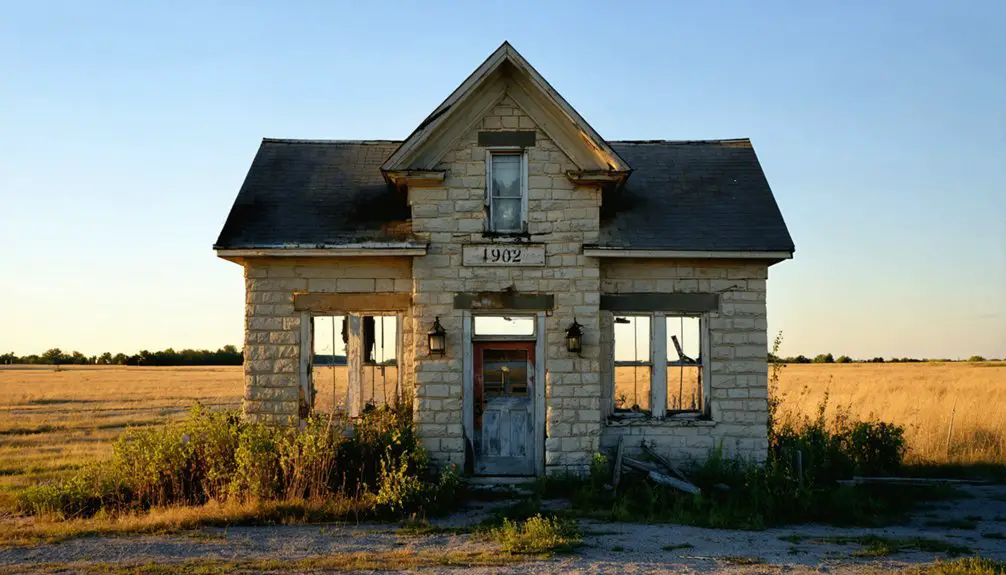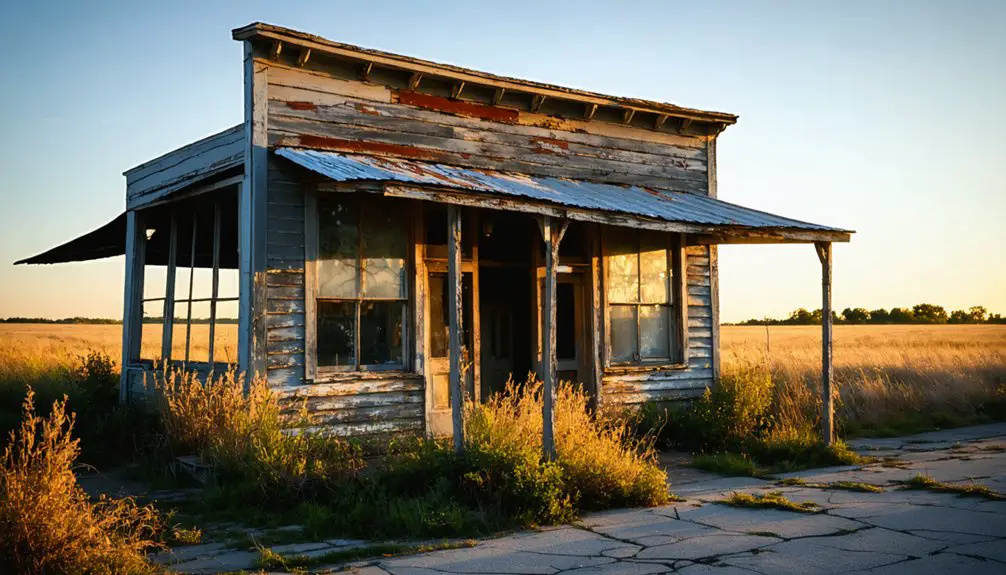You’ll find Lone Star, Kansas as a ghost town near Lawrence, established in 1854 by pro-slavery settlers during Kansas Territory’s contentious pre-statehood period. The settlement peaked at 300 residents in the 1890s, centered around its post office and Church of the Brethren. Today, you can explore its remaining structures, including the historic church, abandoned school, and shuttered post office building. Its transformation from pro-slavery outpost to ghost town reveals deeper tensions that shaped Kansas’ path to statehood.
Key Takeaways
- Lone Star, Kansas began as a pro-slavery settlement in 1854 and evolved into a rural community before declining into a ghost town.
- The population decreased from 300 residents in the 1890s to 213 by 2025, marking its transformation into a near-abandoned settlement.
- Key remnants include the historic Church of the Brethren, abandoned post office, old school building, and scattered occupied homes.
- The post office’s closure in 1953 marked a turning point in Lone Star’s decline, ending its role as a community hub.
- Natural features now dominate the landscape, with Lone Star Lake and wisteria-covered abandoned structures characterizing the ghost town’s appearance.
The Rise of a Settlement: Pro-Slavery Origins to Free State
When pro-slavery advocates from the southern United States established Lone Star in 1854, they aimed to secure Kansas Territory’s admission as a slave state.
You’ll find this pro-slavery settlement was part of the larger “Bleeding Kansas” conflict, where opposing factions fought over the territory’s future status.
Similar to Columbia’s experience, the settlement faced violent attacks during this turbulent period.
The community initially gained some foothold, establishing a post office named “Bond” in 1875, though it closed within a year.
By 1860, many settlers headed back to their southern homes as Kansas became free, dramatically altering the town’s population and character.
Life in Early Lone Star: 1875-1910
After enduring a brief closure of its original “Bond” post office in 1876, Lone Star emerged as a modest rural settlement of roughly 75 residents by 1910.
The community structure centered around the reopened post office, which provided essential money order services, and the local Church of the Brethren.
You’d find a simple rural lifestyle where settlers named their school after a star they spotted in the Kansas sky, embodying their hopes for this free land.
Located seven miles southwest of Lawrence, the village maintained basic trade activities, though residents relied on larger towns for specialized goods. Like many Kansas settlements, the town’s survival depended on being near major crossroads with access to cattle trails and railroads.
Daily life revolved around agricultural pursuits, church gatherings, and school events, creating a close-knit community despite the challenges of isolation and environmental hardships. Like many Great Plains communities, Lone Star faced significant challenges during the Dust Bowl era, which devastated farming operations.
A Star’s Decline: Population and Economic Changes
Since its peak in the early 1900s, Lone Star has experienced a steady demographic decline that’s transformed it into a ghost town.
You’ll find population dynamics revealing a sharp downturn, with numbers falling from 238 in 2020 to 213 by 2025, reflecting a -3.62% annual decline.
The town’s economic stagnation began with the post office’s closure in 1953, marking a turning point in local commerce.
Located in Rush County, Kansas, Lone Star encompasses over 42 square miles of predominantly rural terrain.
Like many Kansas ghost towns, the community’s decline accelerated due to the loss of transportation routes that once connected it to regional markets.
Today, you’ll see the impact in the $59,566 average household income and a concerning 21.3% poverty rate.
The aging population, with a median age of 52, tells the story of younger residents seeking opportunities elsewhere.
Agricultural mechanization and the lack of economic diversification have left their mark, as larger farms require fewer workers and local businesses struggle to survive in this evolving rural landscape.
Postal Service Legacy and Community Development
You’ll find Lone Star‘s postal legacy began in April 1875 under the name “Bond,” though this first post office operated only briefly until February 1876.
When the post office reopened in October 1899, it adopted the community’s new name “Lone Star,” inspired by settlers who spotted a star while naming the local school.
The town reached a peak population of 300 residents by the mid-1890s, showing remarkable resilience after a devastating fire in 1893. The post office remained an essential hub for local commerce and communication until its final closure in May 1953, marking a significant milestone in Lone Star’s shift toward ghost town status. To avoid confusion with other locations sharing the same name, Lone Star, Kansas is often listed on disambiguation pages for clarity.
Mail Service Evolution
The evolution of Lone Star’s postal service mirrors the town’s own trajectory from frontier settlement to ghost town.
You’ll find the town’s mail service began under the name “Bond” in 1875, only to close within a year during Kansas’s tumultuous frontier period. When it reopened in 1899 as “Lone Star,” the post office became central to community identity and commerce, serving 75 residents by 1910.
You can trace the town’s significance through its postal operations, which expanded to include money order services, facilitating trade and financial transactions for farmers and merchants. The post office was established in 1897 and quickly became a vital communication hub for the growing settlement.
Despite surviving the Great Depression and maintaining service through early 20th-century transformations, Lone Star’s post office finally closed in 1953, marking the community’s decline as automobiles and centralized mail services transformed rural Kansas.
Post Office Location Changes
Located within the heart of what’s now Lawrence, Kansas, Lone Star‘s post office underwent notable location changes that shaped the community’s development.
You’ll find the first post office established in April 1875 under the name “Bond,” serving as a crucial hub for community communication. After closing in February 1876, it reopened in October 1899 with its new identity as “Lone Star,” a name inspired by settlers who spotted a star while naming their community school.
The post office remained a cornerstone of village life until its final closure in May 1953, situated seven miles southwest of Lawrence.
Throughout its operation, it served roughly 75 residents at its peak in 1910, offering money order services and functioning as the town’s primary connection to the outside world.
What Remains Today: Buildings and Landmarks

Standing as proof to Lone Star’s fading legacy, a sparse collection of buildings dots this Kansas ghost town‘s landscape today.
You’ll find a handful of sparsely occupied homes and the historic Lone Star Church of the Brethren among the remaining structures. The old school building, which inspired the town’s name after settlers spotted a star, still stands alongside the shuttered post office and train depot buildings. Like Union Station in 1914, these buildings stand as testaments to early 20th-century architecture.
Natural features have slowly reclaimed the townscape, with wisteria vines wrapping around abandoned structures.
Lone Star Lake, built in the 1930s, lies two miles southwest, while CSX-owned railroad tracks cut through the quiet town.
Though the original commercial district, including saloons and the general store, has vanished, the untouched ghost town ambiance persists in this slice of Kansas history.
Historical Impact on Kansas Territory
Founded in 1854 by southern pro-slavery advocates, Lone Star emerged as a contentious settlement during Kansas Territory’s volatile pre-statehood period.
You’ll find its story deeply intertwined with the pro-slavery tensions that defined Kansas’ path to statehood, as the town’s early settlers actively participated in territorial conflicts against nearby Free-State strongholds like Lawrence.
The settlement’s evolution mirrors the broader transformation of Kansas Territory. As it became clear Kansas would enter the Union as a free state, many original settlers abandoned Lone Star by 1860.
During the Civil War, the area served as a landmark for Confederate guerrilla movements, particularly during Quantrill’s Raid of 1863.
This small community’s journey from a pro-slavery outpost to eventual absorption into Lawrence reflects Kansas’ tumultuous shift from divided territory to free state.
Frequently Asked Questions
Were There Any Notable Civil War Battles Fought in Lone Star?
Like a quiet prairie outpost, you won’t find any major Civil War battles fought in Lone Star. Instead, you’ll discover the area experienced guerrilla raids and smaller skirmishes during this turbulent period.
What Businesses and Industries Operated in Lone Star During Its Peak?
You’d have found trading posts, a post office, and agriculture-based businesses in Lone Star’s heyday. Local merchants supplied goods while ranching and livestock trading supported the town’s modest commerce around 1910.
Did Native American Tribes Have Settlements in the Lone Star Area?
By 1800, over 1,500 Kansa people lived in the region. You’ll find their Native settlements were likely seasonal camps near Lone Star, though tribal history shows no permanent villages directly there.
How Did the Great Depression Specifically Impact Lone Star’s Economy?
You’ll see the Depression hit Lone Star hard, crushing farm incomes and forcing residents to leave. Despite community resilience efforts, the economic decline devastated local trade, ultimately leading to the post office’s closure.
What Role Did the Railroad Play in Lone Star’s Development?
You’ll find the railroad’s significance was limited, as major lines bypassed the town. While nearby rail networks improved transportation impact for the region, Lone Star never secured direct rail connections.
References
- https://legendsofkansas.com/lone-star-kansas/
- https://digging-history.com/2015/04/01/ghost-town-wednesday-rome-kansas/
- https://www.indydailyreporter.com/news/ghost-town-lehunt-history-and-local-legend
- https://legendsofkansas.com/kansas-ghost-town-list/
- https://www.youtube.com/watch?v=OyBXD18P_j4
- https://dianastaresinicdeane.wordpress.com/2012/01/29/columbia-a-kansas-ghost-town-story/
- https://en.wikipedia.org/wiki/History_of_Kansas
- https://freepages.rootsweb.com/~gtusa/history/usa/ks.htm
- https://www.geotab.com/ghost-towns/
- https://www.youtube.com/watch?v=CxPSWCOESdI



